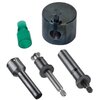I use steno notebooks (the ones that have a spiral ring at the top) because they don't take up as much room on the bench as a lab notebook or a laptop.
Here's what I record for a new load. At the top of the page, I write caliber, projectile type and weight, and powder. I'll also note the primer I'm planning to use. I then transcribe all the published load data I can find with sources. This forces me to pay attention to what kind of variance there is between specific projectiles, notice any out-of-whack data, and generally gives me a good feel for what the real working range is.
If I'm going to be throwing powder on the press, I then adjust the powder dispenser and throw some charges. I just toss the first few back in the hopper, then weigh and record 5 or 6 of them in a row. This gives me a record of what kind of metering I'm dealing with.
I then start loading rounds. I record the headstamp of brass being used. If throwing on the press, I record the specific powder weight thrown by tare weighing cases for the first few rounds, then intermitently for a while thereafter. I record the overall weight and length for the first 15-20 rounds. This gives me a baseline of what a finished round should weigh with the particular components, and what COAL I'm loading to.
After I shoot the new load, I'll make a few notes about what I observed. If I chrono the load, I'll record that.
If I change brass type or charge weight, I'll record the same finished-round-specific data described above until I again can get a feel for what a finished round with the new components should weigh. If I decide to bump the load up or down, I'll do the same. If I change the specific bullet being used, but don't expect it's going I'll also repeat it.
I can write very small, so I can fit several iterations of development and data logging on a single sheet of a steno notebook.
After about 10 years of reloading, I'm into my 4th notebook.









